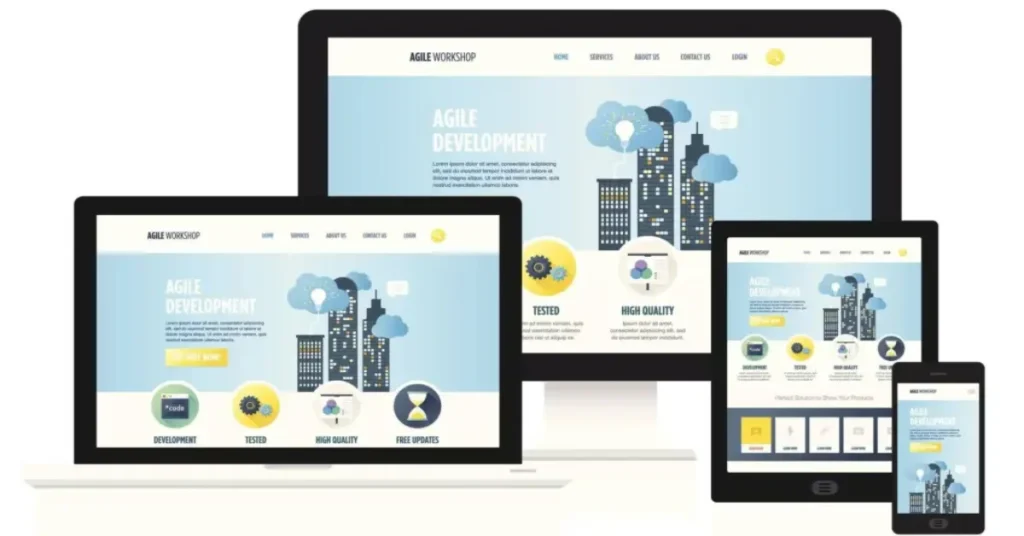Key Takeaways for Your Photography Portfolio Website:
- Your website is your primary online showcase and marketing tool.
- Clean, minimalist design puts your photos first.
- Easy navigation ensures visitors explore your work.
- Mobile-friendly websites reach more US viewers.
- Fast loading times keep visitors engaged.
- Choose a platform that suits your skills and needs.
- Organize galleries clearly to highlight your best images.
- Your “About” page builds trust with US clients.
- Clear contact info and calls to action drive business.
- SEO helps potential clients find you online.
- Regular updates keep your site fresh and relevant.
Crafting Your Killer Photography Portfolio Website

Your photography portfolio website is more than just a place to display pictures. It is your digital storefront, your 24/7 representative, and a powerful tool to attract clients.
Think of it as the foundation of your photography business online. A well-designed site makes a strong first impression and encourages potential clients to explore your talent further.
This article provides a clear blueprint for building a photography portfolio website that not only looks great but also works effectively to grow your business.
According to Studio Pod, the photography industry is thriving, with the global services market expected to grow from $35.78 billion in 2024 to $64.68 billion by 2034.
This growth is largely driven by the surging demand for high-quality visuals in e-commerce and social media, and by technological advancements like AI editing.
Despite the dominance of smartphone photography (over 92% of all photos), there’s strong demand for professional services in niches like wedding, portrait, and drone photography.
The industry is also seeing a rise in freelance photographers and a focus on authentic, inclusive imagery. While competitive, the sector continues to adapt and innovate.
Phase 1: Planning and Strategy – Know Your Audience and Brand

Before thinking about layouts or colors, you must understand your brand and who you want to reach in the diverse US market. What makes your photography unique?
What kind of clients are you hoping to attract? For instance, if you specialize in wedding photography in California, your website’s vibe might differ significantly from someone focusing on corporate headshots in New York City.
Consider your visual identity. What feelings do your photos evoke? Your logo, color choices, and typography should reflect this.
Keep it consistent across your website to build a recognizable brand. Think about how major US brands use visual elements to communicate their identity.
Next, map out how visitors will move through your website. Imagine a potential client landing on your homepage.
Where should they go next? Clear and logical navigation is essential. Most photography websites include pages like Galleries, About, Contact, and sometimes a Blog.
Plan this structure to ensure a smooth journey for your visitors. What do you want your website to do? Generate inquiries? Sell prints?
Showcase your expertise to land commercial gigs? Define these goals early. Your design and content should then support these objectives within the US market.
For example, if you want to sell prints, your website needs an e-commerce section with secure payment options common in the US.
Phase 2: Design and Development – Building Your Online Space

Now, let’s talk platforms. Several website builders cater to photographers. Squarespace is popular for its ease of use and visually appealing templates.
Wix offers a lot of flexibility with drag-and-drop features. WordPress.org, while requiring more technical know-how, provides immense customization through themes and plugins.
Adobe Portfolio integrates well if you already use Adobe’s Creative Suite. Specialized platforms like Pixpa and Format offer features specifically designed for showcasing photography.
Consider your technical comfort level and budget when choosing a platform. Some platforms have monthly fees, while others require you to handle hosting separately.
Think about what features are most important for your US-based business. Do you need built-in e-commerce? Client proofing?
Once you choose a platform, select a clean and user-friendly layout. Remember, your photos are the stars. The design should support, not distract from, your images.
Think minimalist. Use plenty of white space. Ensure your website is easy to read and navigate. Look at successful US photographers’ websites for inspiration on effective layouts.
Crucially, your website must work perfectly on all devices. Mobile browsing is huge in the US.
Statista’s overview on mobile internet highlights its widespread global adoption, with over 5.64 billion people (68.7% of the world’s population) using the internet as of April 2025.
A significant majority, 95.9% of internet users, access it via mobile phones, which now account for 62% of global web traffic.
The growth of mobile internet is fueled by increasing smartphone penetration (7.4 billion in use, accounting for 87% of mobile phones) and the affordability of mobile data.
Key activities on mobile devices include gaming, listening to music, using social media, and watching videos.
While internet adoption is high in many regions, disparities exist, particularly in Southern and Eastern Asia and Africa.
A responsive design adapts to different screen sizes, ensuring a consistent experience on phones, tablets, and desktops.
Test your website on various devices to confirm it looks and functions correctly. Studies show that a significant percentage of website traffic now comes from mobile devices.
Your photography portfolio website absolutely must shine on every screen. Since most potential clients in the US now browse on their phones, getting your site’s mobile experience right is non-negotiable.
If you’re ready to make your website truly accessible and impactful for phone users, dive deeper into Mobile Website Design: Create Killer Mobile Mastery in 2025.
Finally, optimize your images for the web. Large, uncompressed images will slow down your site. Slow loading times frustrate visitors, and search engines penalize slow websites.
According to Google Core Web Vitals are key metrics for measuring website user experience, directly impacting search rankings. They focus on three areas:
- Largest Contentful Paint (LCP): Page loading speed (ideally under 2.5 seconds).
- Interaction to Next Paint (INP): Page responsiveness to user interactions (ideally under 200 milliseconds).
- Cumulative Layout Shift (CLS): Visual stability, preventing unexpected content shifts (ideally under 0.1).
Optimizing these vitals leads to better user experience, higher search rankings, and improved engagement.
Tools like Google Search Console, PageSpeed Insights, and Lighthouse help measure and improve these metrics.
Use tools to compress your images without losing too much quality. Aim for fast loading times to keep potential US clients engaged.
Thinking about bringing in outside help for your website design? Many photographers consider hiring professionals to build their online portfolio.
If that’s you, make sure you know what to look for! Before you commit, learn how to avoid these 5 costly mistakes when hiring freelance web developers to ensure your project stays on track and within budget.
Phase 3: Content Creation and Presentation – Show Your Best Work

Your galleries are the heart of your photography portfolio website. Curate your absolute best work.
Only include images that showcase your skills and align with the type of photography you want to attract.
Organize your galleries logically. You might group them by genre (weddings, portraits, landscapes) or by project.
Think about how you present your images. Should they be in a grid, a slideshow, or a combination? Consider the user experience.
Make it easy for visitors to view your photos in detail. For client work, you might consider password-protected galleries for privacy.
Your “About” page is your chance to connect personally with potential US clients. Tell your story. Share your passion.
Explain your approach. Include a professional photo of yourself to build trust. Make it relatable and engaging. Why should someone in the US choose you as their photographer?
Make it incredibly easy for people to contact you. Your contact information should be prominent on every page. Include an email address, phone number (if applicable), and a contact form.
Consider adding a call to action, such as “Book a Session” or “Request a Quote,” on relevant pages to encourage inquiries from US visitors.
Consider adding a blog or journal section. This can be a great way to share recent work, behind-the-scenes stories, or photography tips.
A blog not only engages potential clients but also helps with SEO by providing fresh content for search engines to index, making it easier for people in the US to find you through relevant searches.
Phase 4: Optimization and Promotion – Getting Found Online

Search engine optimization (SEO) is vital for attracting organic traffic from the US.
Research relevant keywords that potential clients might use when searching for photographers in your niche and location.
Incorporate these keywords naturally into your website content, page titles, and meta descriptions.
Optimize your images for SEO by using descriptive file names and alt text. Alt text helps search engines understand what your images are about.
If you focus on a specific geographic area in the US, include location-based keywords in your website content.
Connect your website to your social media profiles. Make it easy for visitors to follow you on platforms like Instagram, Facebook, and Pinterest, which are widely used.
Consider embedding social media feeds on your website to show your recent activity.
Use website analytics tools like Google Analytics to track your website traffic and understand how visitors interact with your site.
This data can provide valuable insights into what’s working and what needs improvement.
Phase 5: Maintenance and Evolution – Staying Current

Your website is not a static entity. Regularly update your portfolio with your latest and best work. Remove outdated or weaker images. Keep your website content fresh and relevant.
Stay informed about current web design trends and user expectations in the US. What looks modern and professional?
Ensure your website remains secure and performs optimally. Regularly check for updates to your chosen platform and plugins.
General Photography Portfolio Advice
Some areas where common photography portfolio advice misses important points for the US market. Let’s look closer at these:
- Region-Specific Portfolio Expectations: Are there unspoken rules or preferred styles within different US regions? For example, a wedding photography portfolio targeting clients in the Southern US might emphasize a more traditional, romantic style, while a portfolio in a trendier West Coast city could lean towards a more contemporary, artistic approach. I wonder if studies have explored these regional aesthetic preferences in photography within the US. Perhaps future research could analyze the visual language used by successful photographers in different states.
- Pricing Strategies Based on Portfolio Strength (US Market): We see salary statistics, but how does a strong portfolio directly translate to higher prices in the US? Imagine two photographers in the same city. One has a mediocre portfolio, the other a stunning one. The latter likely commands higher rates. I’m curious about data that connects portfolio quality to earning potential, specifically within the US market. Maybe future surveys could ask US photographers about their pricing strategies and how their portfolio influences their fees.
- Legal and Business Considerations for US Portfolios: US-specific legal aspects like copyright and model releases are crucial. Think about a photographer showcasing a portrait without a model release – this could lead to legal issues in the US. Are there best practices for displaying copyright information clearly on a photography website in the US? Future legal tech could perhaps offer automated tools to help photographers manage these legal requirements online.
- Local Portfolio Review Opportunities or Communities: Finding feedback can be tough. Are there active photography portfolio review groups or mentors within specific US cities? Imagine a new photographer in Chicago wanting constructive criticism. Connecting them with local experienced professionals would be invaluable. Perhaps online platforms could create localized networking features for photographers in the US.
- Impact of US-Specific Economic Factors: How do economic ups and downs in the US affect what clients look for in a photography portfolio? During a recession, businesses might prioritize commercial photographers with portfolios showcasing cost-effective solutions. Economic studies focusing on the creative industries in the US could explore this connection.
- University/Educational Portfolio Requirements in the US: For aspiring photographers applying to US universities, what exactly do photography programs look for in a portfolio? Are there national standards or significant variations between institutions? Future educational resources could provide clearer guidelines and examples of successful application portfolios for US programs.
- Job Market Insights Based on Portfolio (US): How do different portfolio styles align with job opportunities in the US? An editorial photography portfolio might be crucial for landing magazine work, while a commercial portfolio is essential for advertising gigs. I’d be interested to see data that maps specific portfolio content to job success rates in different photography sectors within the US.
By addressing these US-specific nuances, your photography portfolio website can become an even more powerful tool for success in the American market.
Conclusion: Your Website – Your Canvas for US Photography Success
Your photography portfolio website is your most important online asset. By focusing on clean design, user experience, SEO, and content that resonates with your target audience, you can create a powerful platform to showcase your talent and grow your business.
Even with a stunning photography portfolio, budget is often a real concern for many photographers, especially those just starting or managing a small business.
You want a professional online presence without breaking the bank. If you’re navigating these waters and seeking smart ways to get a high-quality website without overspending, consider checking out our insights on affordable web design for small business on a budget.
Remember to think strategically, design thoughtfully, and continuously refine your online presence to thrive in the dynamic US photography market.





